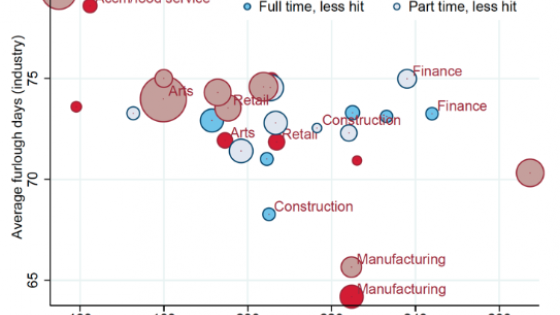As Europe faces new economic challenges and debates the future of industrial policy, the legacy of the COVID-19 pandemic looms large. The unprecedented amount of state aid granted to businesses during the pandemic has reignited discussions about the role and effectiveness of government intervention – not only in emergencies but also in shaping the EU’s long-term industrial strategy, including the Clean Industrial Deal.
A new era of state aid
In response to the economic crisis triggered by the COVID-19 pandemic, the European Commission lifted some provisions of the state aid control framework, adopting the State Aid Temporary Framework in March 2020. Between 2020 and 2022, EU member states approved almost €500 billion in state aid measures under this framework – an unprecedented scale in Europe – raising important questions about the economic effectiveness and competitive effects of these interventions (see Figure 1).
Figure 1 Aid expenditure in the EU (€ million)
Source: Authors’ elaborations on data from the State Aid Reporting Interactive (SARI2) Version March 2023.
The objectives of the Temporary Framework were clear: to ensure liquidity to firms facing sudden revenue collapses, safeguard employment and productive capacity, and mitigate the risk of long-term structural damage. Its flexibility allowed member states to act quickly and tailor support to national needs. Spain and Italy, two of the countries hardest hit by the pandemic, took full advantage of these measures, mobilising billions of euros to support businesses across all sectors and sizes.
Despite the scope of the intervention, there is still limited and fragmented evidence on the effectiveness of COVID-19 state aid for the EU economy. Recent research paints a generally positive picture. Harasztosi et al. (2022) found that EU-wide aid promoted investment and digital transformation. Konings et al. (2023) reported positive, albeit temporary, effects on productivity and firm survival in Belgium. However, the effect on productivity may mask opposing forces, namely, a negative within-firm effect and a positive between-sector effect (e.g. Thwaites et al. 2021 and Bloom et al. 2025). Bighelli et al. (2023) demonstrated that the aid primarily benefited firms most impacted by the crisis. Franco et al. (2024) find that larger and older firms experienced revenue declines similar to or greater than those of smaller firms during the COVID-19 crisis and recovery.
Yet important questions remain: Which firms benefited the most? Did the aid increase revenues and investment, or did it merely replace private financing? Do the effects differ between countries, depending on the policy instruments and approaches adopted? How should these findings influence the design of future crisis support and industrial policy?
Spain and Italy as case studies
To shed light on these questions, we analysed the impact of state aid on the effects of the pandemic in Spain and Italy, two countries that experienced severe health crises and deep economic contractions (Canzian et al. 2024, 2025). Spain’s GDP shrank by 10.8% in 2020 and Italy’s by 8.9%, both significantly exceeding the EU average. In response, both countries issued substantial business support measures, albeit with differences in the timing and targeting of their interventions. We examined whether COVID-19 aid had a measurable effect on firms’ revenues and investments, and whether small firms benefited differently from these programmes – since these were designed to support small and medium enterprises unconditionally.
We carry out a firm-level empirical analysis based on administrative data from national state aid registries and financial data from the Bureau van Dijk’s Orbis database. The analysis compares the performance of firms that received COVID-19 aid with a control group of non-aided firms with similar pre-existing characteristics. Firms were categorised by size – micro, small, medium, and large – based on employee numbers and turnover. The study examines outcomes over a two-year period after the onset of the pandemic, focusing on changes in revenues, investment in tangible and intangible assets, and employment where data allowed.
To identify causal effects, we use a combination of propensity score matching and difference-in-differences. This methodology compares the evolution of key performance indicators over time between supported and unsupported firms, while accounting for their similarity in terms of likelihood of receiving aid. By tracking both groups before and after the introduction of support measures, the difference-in-differences model controls for common trends and unobserved, time-invariant firm characteristics. This allows the specific impact of state aid to be isolated.
Who benefited from COVID-19 aid?
Our findings reveal substantial differences in the effectiveness of COVID-19 state aid by firm size. In both Spain and Italy, micro and small beneficiaries experienced significantly higher revenues compared to similar non-aided firms two years after the crisis, despite being more severely affected by the pandemic in 2020. In Italy, these benefits appeared relatively quickly, with micro-firms showing increased turnover as early as 2021 (Figure 2). In Spain, positive effects emerged more gradually and were more modest: turnover among firms outperformed that of their non-aided peers by 1%, compared to a 5% increase in Italy.
Figure 2 The effect of receiving COVID-19 aid on firm’s turnover, by firm size
Notes: Each panel displays on the y-axis the point estimates from the matching difference-in-differences model for turnover. The vertical bars represent 95% asymptotic confidence intervals. Regressions include fixed effects and controls.
By contrast, no measurable effects on revenues were observed for medium and large firms that received COVID-19 aid. This suggests that, at least in the cases of Spain and Italy, state support for larger companies had little to no impact on their post-crisis performance. These findings are consistent across both countries, despite differences in the implementation of national aid schemes.
A second important finding is that micro and small firms increased their investment in tangible and intangible assets at a higher rate than their non-aided counterparts. These effects are statistically and economically significant, indicating that targeted support for the smallest firms can enhance their resilience and growth capacity by, for example, incentivising investments in digital technologies and innovation.
Figure 3 The effect of receiving COVID-19 aid on various components of total assets for micro and small firms
Notes: Each panel displays on the y-axis the point estimates from the matching difference-in-differences model for the components of total assets on the subsample of micro and small firms. The vertical bars represent 95% asymptotic confidence intervals. Regressions include fixed effects and controls.
Sectoral analysis highlights that construction firms benefited more from aid, with notable gains in turnover, investment, and employment. Interestingly, Spanish firms tended to invest more in intangible assets – pointing to digitalisation and technology upgrades – while Italian firms focused more on tangible investments, especially in construction and wholesale trade. Repeated rounds of aid did not yield additional gains, indicating that the timing and targeting of support mattered more than its frequency.
Economic and policy implications
These findings have important implications for current policy debates, including the future design of crisis-related state aid frameworks and industrial policy instruments. First, the effectiveness of support for micro and small firms strengthens the economic argument for targeted, temporary crisis aid. These businesses are generally more vulnerable to liquidity shocks and face tighter financing constraints; therefore, well-designed public support is particularly important for preserving productive capacity and employment. Empirical studies suggest that targeted job-retention schemes preserved employment without hindering productivity-enhancing reallocation. Overall, government support mitigated the crisis’s impact without distorting creative destruction (see Calligaris et al. 2024). Further strong evidence of the success of targeted government policies in keeping firms afloat and retaining employees is provided by Scur et al. (2020), using firm-level survey data from Denmark.
Second, the absence of measurable benefits for medium and large firms may be due to a combination of substantive and methodological factors. Nevertheless, this result emphasises the importance of at least critically scrutinising substantial public subsidies for large companies in times of crisis. Such subsidies often crowd out private financing or prop up firms that would survive without state aid, generating unnecessary fiscal costs and risking market distortions. This issue is particularly relevant as the EU considers large-scale industrial subsidies under the Clean Industrial Deal. Proposals for generous, broad-based support for large companies must be carefully balanced against the limited evidence of their effectiveness in promoting investment and productivity, as well as their fiscal burden and potential to harm competition.
Finally, extensive support for large firms has the potential to create competitive imbalances, both within EU member states and across the EU’s internal market, also considering that wealthier member states can deploy more generous aid. Careful targeting and coordination of crisis support are necessary to safeguard a level playing field.
Conclusion
Our study highlights the value of rigorous ex-post assessment of state aid programmes. Systematic evaluations based on firm-level data are essential for evidence-based policymaking and should become standard practice, informing both crisis management and long-term industrial policy.
Our findings suggest that providing targeted, temporary support to vulnerable small businesses is important for promoting economic resilience without causing major distortions. In contrast, we found few measurable economic benefits for larger firms, although this may also be partly due to methodological limitations. Nevertheless, such interventions carry a greater risk of distorting competition and trade and so require careful consideration when designing future policies.
As the EU moves into the next phase of policymaking, with the new Commission preparing its policy agenda for 2030, these insights highlight the importance of targeted, evidence-based interventions – both for future crisis responses and the long-term design of industrial policy. Public resources should be strategically directed where they deliver the greatest economic and social value, while safeguarding fair competition and minimising unnecessary fiscal burdens.
References
Bighelli, T, T Lalinsky, and J Vanhala (2023), “Cross-country evidence on the allocation of COVID-19 government subsidies and consequences for productivity”, Journal of the Japanese and International Economies 68: 101246.
Bloom, N, P Bunn, P Mizen, P Smietanka, and G Thwaites (2025), “The impact of COVID-19 on productivity”, Review of Economics and Statistics 107(1): 28–41.
Calligaris S, G Ciminelli, H Costa, C Criscuolo, L Demmou, I Desnoyers-James, G Franco, and R Verlhac (2024), “Employment dynamics across firms during COVID-19: The role of job retention schemes”, VoxEU.org, 9 March.
Canzian, G, E Crivellaro, T Duso, A Ferrara, A Sasso, and S Verzillo (2024), “Study on the effectiveness of COVID-Aid on firms”, European Commission.
Canzian, G, E Crivellaro, T Duso, A Ferrara, A Sasso, and S Verzillo (2025), “The impact of financial support to firms during crises: The case of Covid aid in the EU”, CEPR Discussion Paper 20172.
Franco G, M Hitschfeld, A Pina, and D Puy (2024), “Large and small firms in the COVID-19 crisis and implications for competition”, VoxEU.org, 1 June.
Harasztosi, P, L Maurin, R Pal, D Revoltella, and W Van Der Wielen (2022), “Firm-level policy support during the crisis: So far, so good?”, International Economics 171: 30–48.
Konings, J, G Magerman, and D Van Esbroeck (2023), “The impact of firm-level Covid rescue policies on productivity growth and reallocation”, European Economic Review 157: 104508.
Scur, D, B Larsen, I Schmutte, and M Bennedsen (2020), “Understanding the impact of government aid to firms in the COVID-19 pandemic”, VoxEU.org, 28 June.
Thwaites, G, P Smietanka, P Bunn, P Mizen, and N Bloom (2021), “The impact of Covid-19 on productivity”, VoxEU.org, 18 January.












